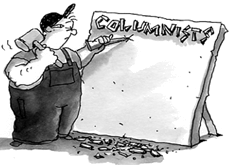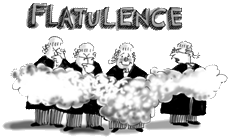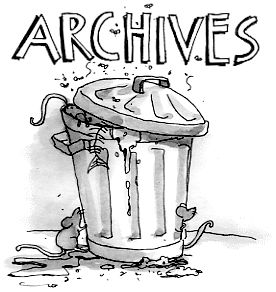Making the law fit
 Tulkinghorn •
Tulkinghorn •  Thursday, November 11, 2010
Thursday, November 11, 2010 J.J. Spigelman says it's easy for judges to make the law fit the result they want ... Plenty of froufrou can be conjured to enhance the judicial image ... Tulkinghorn opines on the secret lives of judges ... The curtain opens for a minute  Judges ascertain facts and law, and then apply law to the facts, thus producing a "legal" outcome, which was always inevitable.
Judges ascertain facts and law, and then apply law to the facts, thus producing a "legal" outcome, which was always inevitable.
Judges must say this, and the general public must accept it. As Duke University law professor Barak Richman says :
"We must not look behind the curtain, for once we realize that judges are as ideological, cognitively biased, and expedient as other human beings, we will begin to question the social norms that serve as irreplaceable societal foundations."
The hoi polloi like to peek behind curtains. The judges must say, "nothing to see here".
In October The Sydney Morning Herald ran a series of articles entitled Behind the Bench and as part of that, readers were given an expose of "The Secret Lives of Judges".
However, in these sorts of exercises the judges control the flow of information.
The journalists who did the interviews could not realistically ask judges how often they injected their own politics and prejudices into their decisions.
Judges wouldn't tolerate requests for more information on that. Callinan: cat out of the bagHowever, from time to time various jurisprudential cats have stuck their heads out of judicial bags.
Callinan: cat out of the bagHowever, from time to time various jurisprudential cats have stuck their heads out of judicial bags.
In 2007 retired High Court Justice Callinan said:
"When I was at the bar, I sometimes thought, and not just in constitutional cases, that judges were not always as candid about their real reasons for deciding a case as they might have been."
On October 22 NSW Chief Justice Spigelman said it was easy for judges to hide their real reasons.
"It is all too easy to dress up a conclusion, reached on other grounds, by selecting from the smorgasbord of maxims and principles of interpretation those which assist the achievement of the pre-determined result."
One wonders when he discovered how easy it was.
He added:
"However, intellectual honesty is a core obligation of the judicial oath."
The NSW judicial oath itself doesn't mention honesty, intellectual or otherwise.
One might have thought that if "intellectual honesty" was a core obligation of the judicial oath, then the oath would include it.
The oath is short. It imposes duties to serve the Queen, "do right", and to avoid being biased (which means avoiding the appearance of bias).
The oath can't include honesty clauses, because our courts are adversarial, so it is not the role of judges to try and find out the honest truth.
Truth seeking justice systems can require honesty of their judges. A Finnish judge, for example, promises:
"I shall never, under any pretext, pervert the law nor promote injustice because of kinship, relationship, friendship, envy, hatred or fear, or for the sake of gifts or presents or other reasons, nor shall I find an innocent person guilty or a guilty person innocent... All of this I wish to and shall fulfil faithfully, honestly and as an earnest judge, without deceit and intrigue."
 Jacobs: insidious bias of judgesIn 2006 Dennis Jacobs, the Chief Judge of United States Court of Appeals for the Second Circuit, published an article with a title remarkably similar to the SMH's sub-title Secret Lives of Judges. Jacobs' article was entitled The Secret Life of Judges and it was a lot more informative.
Jacobs: insidious bias of judgesIn 2006 Dennis Jacobs, the Chief Judge of United States Court of Appeals for the Second Circuit, published an article with a title remarkably similar to the SMH's sub-title Secret Lives of Judges. Jacobs' article was entitled The Secret Life of Judges and it was a lot more informative.
Jacobs said:
"When I refer to the secret life of judges, I am speaking of an inner turn of mind that favors, empowers, and enables our profession and our brothers and sisters at the bar. It is secret, because it is unobserved and therefore unrestrained - by the judges themselves or by the legal community that so closely surrounds and nurtures us.
It is an ambient bias. The result is the incremental preference for the lawyered solution, the fee-paid intervention or pro bono project, the lawyer-driven procedure, the appellate dispensation - and the confidence and faith that these things produce the best results. It is an insidious bias."
Jacobs sets out many reasons why the general public might resent the way lawyers and judges run the legal system. For example:
"Every problem-solving profession - except ours - quickly adopts as preferred the solution that is simplest, cheapest, and most efficacious."
One can assume that the NSW judiciary broadly supported the SMH Behind the Bench initiative, but if the judges weren't going to engage in discussion about the major problems of adversarialism and interpretation, then why bother?
Actually, such an approach makes sense. An institution can improve its image by avoiding discussing substance, and instead dishing out trivia and symbolism.
In 1974 US political scientist Greg Casey wrote in The Supreme Court and Myth: An Empirical Investigation that two academics Maclver and Edelman had suggested that a political institution such as the US Supreme Court ...
"can heighten its legitimacy by showing to its public symbols and ceremony rather than revealing its true nature, its concrete reality."
The multi media presentation for Behind the Bench probably achieved that, with lots of legal robes and law books on display (click PLAY).
In 2007 US academics James Gibson and Gregory Caldeira visited Casey's work in their book Citizens Courts and Confirmations (2009) (at p.9) and wrote:
"Long ago, Casey (1974) demonstrated that the more [ordinary people know] about law and courts, the less realistic are perceptions of judicial decision (i.e. the more one is likely to believe in the theory of mechanical jurisprudence)."
If mechanical jurisprudence (applying law and not personal ideology) was the norm, then this sort of thing could not occur:
In 1998 maximum penalties for "high range" drunk driving (both fines and jail maximums) were doubled.
Over the next four years the median fine for such offences went up 40 percent, not 100 percent.
The imprisonment rate over the same four years actually dropped - from 2.9 percent of offenders to 2.4 percent.
The number of offenders granted a discharge without conviction (even though they had been proved guilty) increased from 5.9 percent to 9.7 percent. See HERE.
The tension between "we have to do what the law says" and "we can avoid what the law says" was nicely on view in Putting the truth into sentencing.
Chief NSW District Court judge Reg Blanch said:
"The gradual increase in law-and-order measures have forced judges to impose higher sentences for some crimes... They can't avoid it. You might disagree with the legislation violently but you've sworn an oath to administer the law."
Retired Supreme Court Justice Rod Howie, however, singled out District Court judges for "'refusing to apply' the standard non-parole period and the guideline judgment for drink driving".
Then he indicated that might not be true, but if it was, then "the DPP should take them on and [appeal]".
Judges can't avoid applying the law, but sometimes they can, and if they do, then the DPP should do something about it.
Judicial accountability in action.
Now, please close that curtain.









Reader Comments